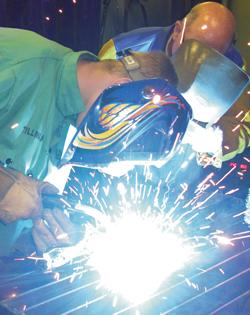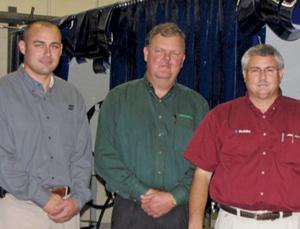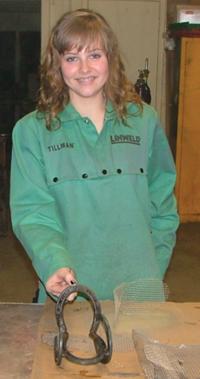- FMA
- The Fabricator
- FABTECH
- Canadian Metalworking
Categories
- Additive Manufacturing
- Aluminum Welding
- Arc Welding
- Assembly and Joining
- Automation and Robotics
- Bending and Forming
- Consumables
- Cutting and Weld Prep
- Electric Vehicles
- En Español
- Finishing
- Hydroforming
- Laser Cutting
- Laser Welding
- Machining
- Manufacturing Software
- Materials Handling
- Metals/Materials
- Oxyfuel Cutting
- Plasma Cutting
- Power Tools
- Punching and Other Holemaking
- Roll Forming
- Safety
- Sawing
- Shearing
- Shop Management
- Testing and Measuring
- Tube and Pipe Fabrication
- Tube and Pipe Production
- Waterjet Cutting
Industry Directory
Webcasts
Podcasts
FAB 40
Advertise
Subscribe
Account Login
Search
A journey of 1,000 welds
What began as an idea continues with perseverance and faith
- By Amanda Carlson
- May 9, 2011
- Article
- Arc Welding

Republic County High School welder Bret Filipi lays a bead as his teacher, Dan Stehlik, watches in the background. Republic adopted the weld program in 2007.
Doug Wilkinson, director of manufacturing/operations at Reinke Mfg. Co. Inc., Deshler, Neb., figures there are three ways to address a problem: complain about it; wait for other people to fix it; or fix it yourself.
Instead of complaining about the shortage of quality welders in Deshler, a small farming community in the south-central part of the state, 12 miles from the Kansas state line, Wilkinson did something about it—he sparked a chain of events that led to the creation and implementation of a weld education program for high school students and adults.
Laying the Foundation
Wilkinson has spent the last 11 years at Reinke, a manufacturer of mechanized irrigation systems. In the early 2000s he had grown increasingly dissatisfied with the quality of welders entering his company. Wilkinson prides himself and the company on their ability to train welders to perform the tasks necessary in-house. However, the new welders coming through the doors did not possess the foundation of skills that he thought they should.
"The welders weren't as prepared as we'd like them to be. They could lay a bead, but they really didn't understand gun angle, which in some of the welding we do is important. For the weld to be right, the gun angle has to be right. Plus, they didn't have much metallurgy savvy. Basically, they didn't have what I thought they should have, which is what spurred all of this," Wilkinson explained.
Seven years ago he embarked on a grassroots effort to train and develop a new generation of good welders by creating a weld program within the community that would introduce local people—adults and high school students—to the welding industry and provide them with a solid foundation to build upon.
Wilkinson turned to his good friend and Reinke colleague Wes Mosier, CWE/CWI, welding instructor, to build the curriculum. Mosier was not new to weld education, having spent 12 years as department head of the welding program at Southeast Community College in Beatrice, Neb., before joining Reinke as a weld instructor.
Wilkinson and Mosier sat down and detailed what they wanted the course to accomplish, things like how to operate a torch, how to interpret a blueprint, how to cut parts, and how to weld those parts together.
"The initial phase was to have them earn their D1.1 1G [the flat horizontal position] qualification. But I told [Wes] that I wanted to be able to teach the same curriculum to both high school students and adults," Wilkinson said.
Mosier evaluated the needs of local manufacturers in terms of which welding processes were used heavily and what materials they were welding on; integrated Wilkinson's requirements; and added components of basic metallurgy, quality assurance, weld penetration, and matrix. In a nutshell, he wanted complete welders—not just glorified trigger pullers.
"One of the first things I tell students is that there has to be a reason why you do everything you do. We not only go through the process of creating quality welds, but why," Mosier explained.

Deshler High School, Deshler, Neb., adopted Wilkinson’s weld program in the fall of 2009. Today it’s one of the most popular classes offered.
After about a year of collaborating with Wilkinson and reviewing AWS structural criteria, Mosier finalized a 40-hour program that integrates classroom time and lab training for welders on gas metal arc welding (GMAW). The program can be tailored for various phases and ability levels (beginning, intermediate, advanced), with the goal of preparing students to earn AWS D1.1 or D1.2 qualification.
After successfully completing the mild steel course, students can then move to aluminum GMAW. In both cases, students are taught how to follow a blueprint and welding procedure specification (WPS). They learn everything from GMAW history and modes of transfer to variables, consumables, and proper technique.
Believing Is Seeing
While Mosier was busy writing the program, Wilkinson was on the phone with every high school counselor he could find in the Deshler area to get a sense
of how welding was being portrayed within the schools. After talking to nearly 60 high school and guidance counselors, he found that none of them promoted welding as a career choice to their students.
He was stunned.
"I introduced myself and asked some scripted questions, like if they actively promote welding as a potential career for students. There was always this silence and I'd be sitting there thinking, 'OK, are you going to answer this question or not?' Pretty soon they'd say, 'Well, no. Isn't welding dangerous?'"
It was that moment Wilkinson said he came face-to-face with the uphill climb ahead.
He first approached Deshler High School with the program's concept. They respectfully declined. Wilkinson knew that first "yes" would be tough to come by mostly because it's hard to believe in something that is brand new and untested.
"People have to see it before they can embrace it. There were times when I'd get discouraged, but all I'd need to do was go home and get a little rest. I'd be back ready to go the next day."
He received a glimmer of hope after approaching Republic County High School, Belleville, Kan. The principal at the time, Wilkinson said, seemed cautious yet excited. The next step was to win over the school board. To Wilkinson's surprise, he was met with more optimism.
From there he set his sights on educating the parents and the students. He demonstrated the safety measures that would be put in place. He developed educational DVDs and emphasized growth opportunities in welding careers. He highlighted the industry's technology, including robotics. He made the argument that a diversified educational palette would lead to more opportunities for economic growth within the community. The response was positive and energetic.

Wes Mosier (far left), Danny Fuller, and Dan Stehlik (far right) stand with Bralin Damman and Cameron Trzicky, two of Republic’s first five students to earn AWS D1.1 qualification.
"They saw it as an opportunity, not just for their non-college-bound students, but for all students to learn something that could never be taken away from them. No matter what happens to you in your life, education is something that cannot be taken away from you. I think that's so important, and I think the parents and the school board thought that was important too," Wilkinson explained
In 2007 Republic County High School officially adopted the program. The city of Belleville contributed a transformer and outdoor electrical updates; his employer, Reinke, donated the steel, raw materials, and instructor training; Miller Electric, Appleton, Wis., loaned power sources; and Tillman, Smith Equipment, and Linweld donated supplies as well.
More than 40 students signed up for the inaugural class.
The school partnered with Cloud County Community College, Concordia, Kan., to offer adult education classes that followed the same format as the high school curriculum. Wilkinson figured that the program should target adults as well, expanding the program's reach.
Teaching the Teacher
The success of this program was based largely on the ability of the instructors. Once the program had been adopted, it was important that the instructor be able to teach theory and metallurgy as well as practical, hands-on technique. Both were crucial in preparing students to take and pass the D1.1 certification test.
So Mosier spent the summer of 2007 teaching the instructors welding basics, code work, and weld parameters. One of those instructors was Danny Fuller, a full-time weld technician at Reinke. For Fuller, the class served as a review. But for others who had a more general knowledge of welding, it was intimidating, mostly, guessed Mosier, because they were afraid of failure.
"Some of them were almost ready to throw in the towel. I had to sit down with each of them individually and tell them that they were not going to fail this. We would not allow that to happen," Mosier said.
Added Fuller, "I think the biggest thing was there was a lot more to it than a lot of people realized. We assured them that welding was much more than sticking two pieces of metal together."
Mosier required that most teachers qualify to at least the 3G (vertical-up) position. It was intense, he said, but they left with two things: an AWS structural qualification and a comprehensive understanding of the process and how to teach it.
Once in the classroom, the instructor was paired with a Reinke-employed CWE/CWI who would help guide the instructor through his first experience teaching the program and made sure each student had the best chance of leaving the program with a certification in hand.

Doug Wilkinson (far right) stands in the welding lab at Fillmore Central High School with ESAB Territory Sales Manager Doug Swanson (far left) and Praxair Key Account Manager Jeff Plager (center). Fillmore is the third school to adopt the program.
Fuller assisted Republic County High School instructor Dan Stehlik starting in the fall of 2008.
Where Are They Now?
Today Wilkinson's labor of love continues to grow. While the program's first go-around at Republic County High School was a little bumpy, Wilkinson said they evaluated the good and the bad, learned lessons, and documented it all for future reference. But struggles and all, by year's end seven high school students were far enough along within the program to test for D1.1 1G qualification. Five students passed, earning AWS D1.1 qualification cards. The class has become so popular that it is now offered to sixth-, seventh-, and eighth-graders too.
Two years later, in the fall of 2009, Deshler High School became the second school to adopt Wilkinson's weld program. Southeast Community College joined as a partner and made the program available to its adult students. Fuller currently teaches welding on steel at Deshler for an hour a day, five days a week. He had no idea the program would get this big but is pleased with the impact it is having on his students.
"The coolest thing, especially with these high school kids, has been the fact that they are talking about continuing their education in welding. There are two students that are interested in going to Tulsa Welding School, and there's one who's signed up to take welding classes at the community college. That's been pretty cool, seeing the students make that decision and maybe even being a part in helping inspire them to do that," explained Fuller.
This fall Deshler High School plans to unveil the first known weld academy in the state. Academies, which Wilkinson said are traditionally geared toward math and science classes, enable students from other area high schools to enroll in a particular class at a host school. The host school receives a small stipend from the student's home high school, and the student receives a transferable credit for taking the class.
Fillmore Central High School in Geneva, Neb., became the third school to adopt the weld program in August 2010. ESAB Welding & Cutting Products, Florence, S.C., donated welding power sources to the lab. As the program's first full year comes to a close, 15 of the students will leave with a D1.1 1G qualification and two students will walk away with a D1.2 qualification. Approximately 33 kids are signed up for the beginner class for next fall.
Wilkinson currently is gearing up for a meeting with an economic development group from Concordia, Kan. The group is considering adopting the program at its high school and is planning on touring Fillmore Central's facilities.
Looking back, all of the hard work, the rejections, and the late nights have helped turn Wilkinson's idea into a sustainable educational entity. Some have questioned his motives and accused him of doing this purely to train future Reinke employees. That's not the case, Wilkinson argues.
"When this first started it was about creating more opportunities for people. I've hired a couple of high school kids from Deshler, but I haven't hired a single adult out of Belleville. This wasn't about Reinke. Reinke provided me with the resources to do what I've done, which I appreciate. They've seen the good that has come from this, and I think people have seen that we didn't do this just for our own benefit."
He is reminded of this every time he receives a thank-you note from an adult student who, thanks to welding, has changed his or her career options for the better.

The program at Republic County High School was so popular that it was expanded into its middle school, where students like Kelby Johnson learned welding basics and made projects out of horseshoes.
"We were able to improve their income level by teaching them a skill that nobody else took the time to tell them about. What a success story."
Doug Wilkinson, 402-365-7361, dougwilkinson@reinke.com.
About the Author

Amanda Carlson
2135 Point Blvd
Elgin, IL 60123
815-227-8260
Amanda Carlson was named as the editor for The WELDER in January 2017. She is responsible for coordinating and writing or editing all of the magazine’s editorial content. Before joining The WELDER, Amanda was a news editor for two years, coordinating and editing all product and industry news items for several publications and thefabricator.com.
About the Publication
subscribe now

The Welder, formerly known as Practical Welding Today, is a showcase of the real people who make the products we use and work with every day. This magazine has served the welding community in North America well for more than 20 years.
start your free subscription- Stay connected from anywhere

Easily access valuable industry resources now with full access to the digital edition of The Fabricator.

Easily access valuable industry resources now with full access to the digital edition of The Welder.

Easily access valuable industry resources now with full access to the digital edition of The Tube and Pipe Journal.
- Podcasting
- Podcast:
- The Fabricator Podcast
- Published:
- 04/16/2024
- Running Time:
- 63:29
In this episode of The Fabricator Podcast, Caleb Chamberlain, co-founder and CEO of OSH Cut, discusses his company’s...
- Trending Articles
Sheffield Forgemasters makes global leap in welding technology

Welding student from Utah to represent the U.S. at WorldSkills 2024

Lincoln Electric announces executive appointments

Lincoln Electric acquires RedViking

Engine-driven welding machines include integrated air compressors

- Industry Events
16th Annual Safety Conference
- April 30 - May 1, 2024
- Elgin,
Pipe and Tube Conference
- May 21 - 22, 2024
- Omaha, NE
World-Class Roll Forming Workshop
- June 5 - 6, 2024
- Louisville, KY
Advanced Laser Application Workshop
- June 25 - 27, 2024
- Novi, MI


























